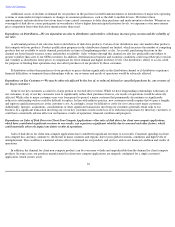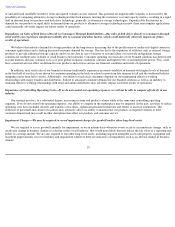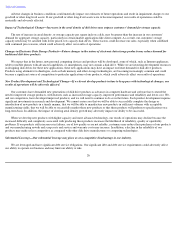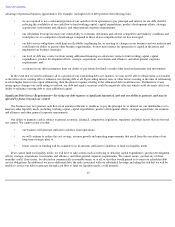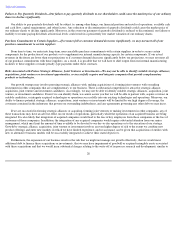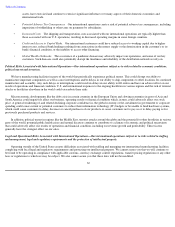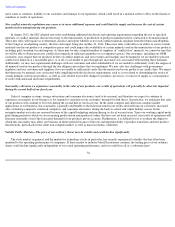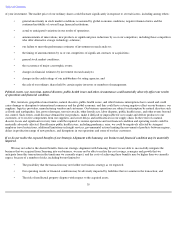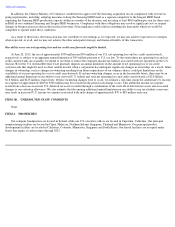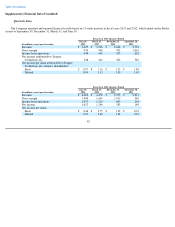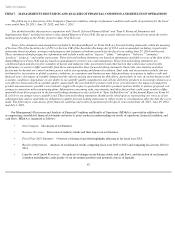Seagate 2012 Annual Report Download - page 37
Download and view the complete annual report
Please find page 37 of the 2012 Seagate annual report below. You can navigate through the pages in the report by either clicking on the pages listed below, or by using the keyword search tool below to find specific information within the annual report.
Table of Contents
more states or countries, liability to our customers and damage to our reputation, which could result in a material adverse effect on the financial
condition or results of operations.
New conflict minerals regulations may cause us to incur additional expenses and could limit the supply and increase the cost of certain
metals used in manufacturing our products.
In August 2012, the SEC adopted new rules establishing additional disclosure and reporting requirements regarding the use of specified
minerals, or conflict minerals, that are necessary to the functionality or production of products manufactured or contracted to be manufactured.
These new rules will require us to determine, disclose and report whether or not such conflict minerals originate from the Democratic Republic
of the Congo or an adjoining country, the first such report being due on May 31, 2014. These new rules could affect our ability to source certain
materials used in our products at competitive prices and could impact the availability of certain minerals used in the manufacture of our products,
including gold, tantalum, tin and tungsten. As there may be only a limited number of suppliers of "conflict free" minerals, we cannot be sure that
we will be able to obtain necessary conflict free minerals in sufficient quantities or at competitive prices. Our customers, including our OEM
customers, may require that our products be free of conflict minerals, and our revenues and margins may be harmed if we are unable to procure
conflict free minerals at a reasonable price, or at all, or are unable to pass through any increased costs associated with meeting these demands.
Additionally, we may face reputational challenges with our customers and other stakeholders if we are unable to sufficiently verify the origins of
all minerals used in our products through the due diligence procedures that we implement. We may also face challenges with government
regulators and our customers and suppliers if we are unable to sufficiently verify that the metals used in our products are conflict free. We expect
that there may be material costs associated with complying with the disclosure requirements, such as costs related to determining the source of
certain minerals used in our products, as well as costs related to possible changes to products, processes, or sources of supply as a consequence
of such verification and disclosure requirements.
Seasonality
—Because we experience seasonality in the sales of our products, our results of operations will generally be adversely impacted
during the second half of our fiscal year.
Sales of computer systems, storage subsystems and consumer electronics tend to be seasonal, and therefore we expect to continue to
experience seasonality in our business as we respond to variations in our customers' demand for disk drives. In particular, we anticipate that sales
of our products will continue to be lower during the second half of our fiscal year. In the client compute and client non-compute market
applications of our business, this seasonality is partially attributable to the historical trend in our results derived from our customers' increased
sales of desktop computers, notebook computers, and consumer electronics during the back-to-school and winter holiday season. In the
enterprise market our sales are seasonal because of the capital budgeting and purchasing cycles of our end users. Since our working capital needs
peak during periods in which we are increasing production in anticipation of orders that have not yet been received, our results of operations will
fluctuate seasonally even if the forecasted demand for our products proves accurate. Furthermore, it is difficult for us to evaluate the degree to
which this seasonality may affect our business in future periods because of the rate and unpredictability of product transitions and new product
introductions, particularly in the client non-compute market, as well as macroeconomic conditions.
Volatile Public Markets—The price of our ordinary shares may be volatile and could decline significantly.
The stock market, in general, and the market for technology stocks in particular, has recently experienced volatility that has often been
unrelated to the operating performance of companies. If these market or industry-based fluctuations continue, the trading price of our ordinary
shares could decline significantly independent of our actual operating performance, and you could lose all or a substantial part
34


